10 Home Improvements That Are Not Legal To Do Yourself

When it comes to home improvement projects, doing it yourself can save you money and give you a sense of satisfaction. However, there are certain tasks that legally require a licensed professional due to safety concerns and building codes. Tackling these without the proper knowledge or credentials can result not only in fines, but also pose serious risks to your and your family’s safety. And it might prove illegal.
Trending Now: Housing Market 2024: Zillow Predicts 5 Hottest Home Trends That Homebuyers Will Be Looking For
For You: How To Get $340 Per Year in Cash Back on Gas and Other Things You Already Buy
“The legality of the repairs you perform on your property are subject to the rules and regulations of your local building department,” said Bill Samuel, who runs Blue Ladder Development in Chicago. “The rules will vary from each town, but in general, you will be required to pull a permit for any property alterations beyond basic cosmetic improvements. Not pulling the required permits is considered performing illegal work. Many villages also require specific work to be performed by a licensed professional.”
Before you strap on your tool belt, read the wise words that home improvement pros and others have to share about the dangers of DIY projects.
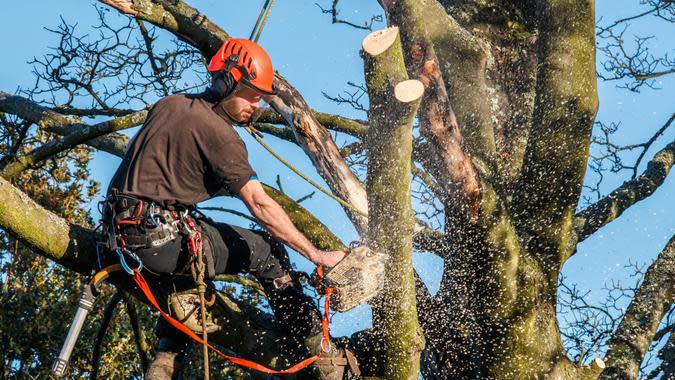
Cutting Down Large Trees
“One of the things we deal with regularly in our line of work is homeowners that are wanting their landscapers to remove large trees or that want to remove them on their own. We’re told this is fine to do if you’re careful and have the right tools. Maybe not the smartest idea, but perfectly legal if it’s your property,” said Dan Bailey, president of WikiLawn Lawn Care.
“This isn’t always true, though. In some states, it’s illegal to cut down large trees if you’re not an arborist or don’t have [the] certification to do so… So if you’re wanting to clear out large trees, definitely don’t do it yourself. It’s dangerous to self and property, and in many cases, it will get you fined.”
According to Angi, the cost to have a tree removed can vary based on how large the tree is and how old it is. Smaller trees can cost around $200, while larger trees cost about $2,000 to remove. The average cost for tree removal is $750.
Find Out: 5 Types of Homes That Will Plummet in Value in 2024
Read Next: I’m a Real Estate Agent — 7 House Features That Buyers Always Overpay For

Replacing an Electrical Panel
The cost of replacing an electrical panel depends on the amperage and whether new wiring is required, but HomeAdvisor puts the average price at about $1,274.
“Some of the worst things and illegal things I have seen homeowners and unlicensed contractors attempt to do is replace their main electrical panel,” said Christopher Haas, the owner of Haas & Sons Electric in Pasadena, Maryland. “This poses many dangers from injuring themselves, the home,and the occupants… I have seen people unknowingly hook up the ground and power wire backward — reverse of what they should have done — which can cause injury or death to any unsuspecting person or animal that touches the now electrified ground.”
Check Out: 10 Things Frugal People Always Do When They First Buy a House

Converting Your Stove From Electric to Gas
The concept of moving from electric to gas cooking sounds simple, but it isn’t.
“Switching your stove from electric to gas is a complicated process that requires permits and a professional’s assistance,” said Emily Perez, head of design and digital PR at Kitchen Infinity. “You’ll need to have a gas line installed and the electrical circuits adequately closed off. This ensures that the final product is safe and functional.”
Angi estimates that the cost for this job ranges anywhere from $125-$2,000.

Taking Out a Wall
“You’d love to have an open floor plan. Before you take a sledgehammer to that wall, you need to talk with an expert,” Perez said. “Some walls in your home are cosmetic, and others are supporting your roof. Knockdown a supporting wall, and you’ve compromised the integrity of your home.”
The cost to remove a wall varies widely, depending on whether it’s cosmetic or load-bearing, the size and whether it’s on the first or second floor. It can run from $300-$10,000, per HomeAdvisor.
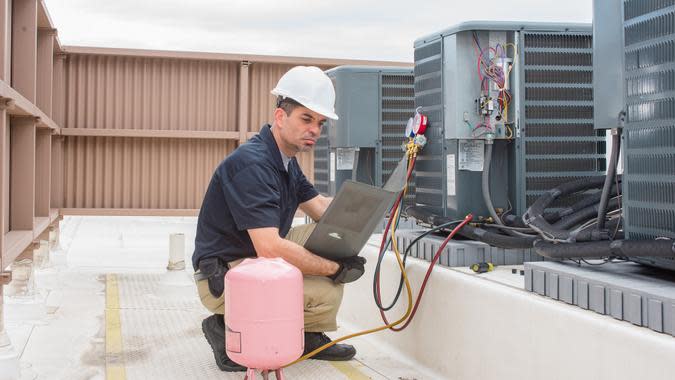
Repairing or Replacing HVAC
If there’s a problem with your heating and air conditioning, it’s always best to call a professional, Perez said.
“There are possible gas leakages that can cause dizziness, asphyxia and other respiratory problems,” she said. “It is because of these health risks it is illegal to fix or replace your HVAC system by yourself. If a manufacturer finds out about your efforts to fix the system yourself, they may even cancel out your warranty.”
It’s always a good practice to have your HVAC system serviced regularly, which costs $200-$600, according to HomeAdvisor.
Explore More: 5 Unnecessary Bills You Should Stop Paying in 2024
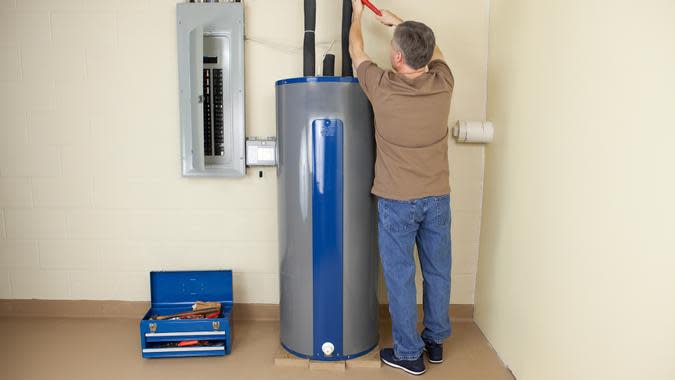
Installing a Water Heater
“You’re either dealing with 220 volts of electricity or a live gas line with the possibility of carbon monoxide poisoning looming in the air,” said Ralph Severson, owner of Flooring Masters and Professional Remodelers. “It is very dangerous for a DIY-inclined homeowner to do this replacement themselves, but there is no shortage of people with a lot more confidence than skill.
“I once got a call from a friend to go look at a new water heater that wasn’t working. The person who installed it for my friend did it for free. They ran a 110-volt line to the heater instead of 220. Needless to say, I didn’t touch it and told them to call both a plumber and electrician immediately.”
According to HomeAdvisor, installing a water heater replacement costs between $880 and $1,778, or an average of $1,304.
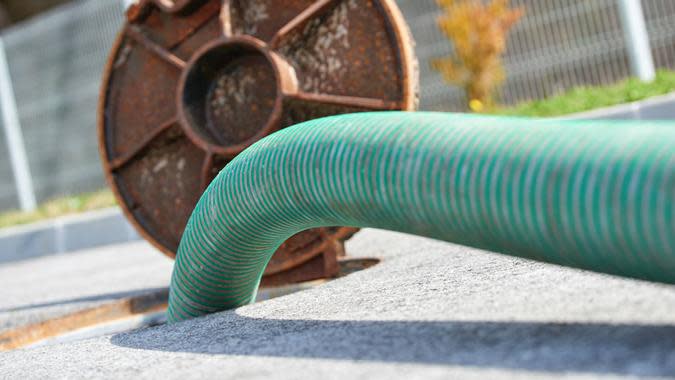
Pumping a Septic System
This is another thing that is taboo for a DIY project, Severson said.
“This waste must be disposed of properly,” he said. “I have heard stories of… people pumping or even siphoning systems themselves. Undoubtedly straight into the yard or a creek.”
HomeAdvisor finds that this costs about $421 on average to have done.
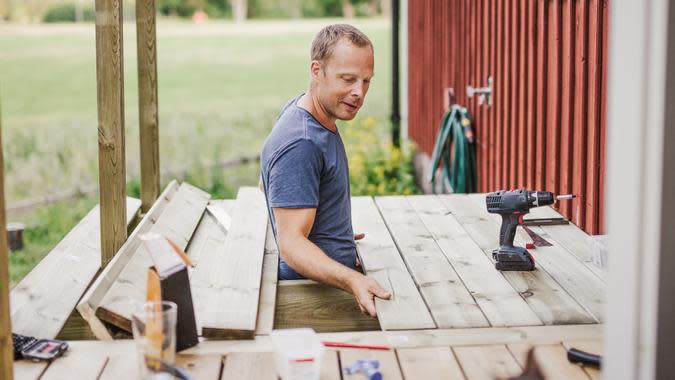
Building a Deck
“The biggest DIY safety issue is, without a doubt, self-built decks,” said Welmoed Sisson, a licensed home inspector in Maryland. “Just about every jurisdiction requires permits for deck construction, but we still see decks that were built by a homeowner with a hammer in one hand and a copy of ‘Family Handyman’ in the other. Not knowing the fundamentals of safe deck construction can lead to disaster.”
An average deck costs $8,003, according to HomeAdvisor.
Discover More: The Most Expensive City in Every State

Adding On
Many do-it-yourself home additions fail to align properly with the existing structure. The add-on may sit at an uneven height or have an awkward roof line in relation to the original home. This can create an unsightly patchwork appearance.
Additionally, homeowners often prioritize speed and cost savings over securing the proper legal permits for add-ons. While expedient in the short term, this oversight causes problems over time.
Legally, unpermitted add-ons provide no added property value and cannot be factored into assessments. Without oversight from building inspectors, these additions may also fail to meet safety and structural codes. It is in every homeowner’s best interest to go through proper legal channels with home improvement projects, even when it requires more time and money upfront. The long-term benefits of increased safety, compliance and property value make the extra effort worthwhile.
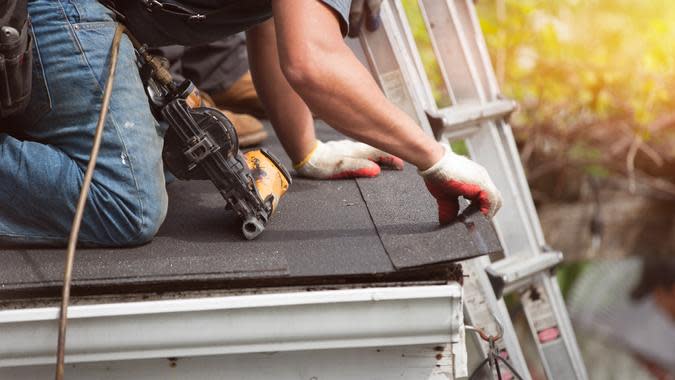
Roofing
Many local building departments require roofers to be licensed with the state.
“Roofing is a good example of a project that, if not done correctly, can cause leaks into your home, causing additional damage,” said Samuel. “Roofing is also a dangerous job that requires specific safety gear and has a high risk of injury for someone new to the job.”
Including materials and labor, a roof costs an average $1.50 to $3 per square foot, HomeAdvisor reports.
Laura Beck and Sam DiSalvo contributed to the reporting for this article.
More From GOBankingRates
Suze Orman: 5 Social Security Facts Every Soon-To-Be Retiree Must Know
Here's How to Add $200 to Your Wallet -- Just For Banking Like You Normally Would
The Biggest Mistake People Make With Their Tax Refund -- And How to Avoid It
This article originally appeared on GOBankingRates.com: 10 Home Improvements That Are Not Legal To Do Yourself
